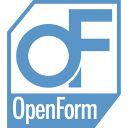Export Points Dialog¶
Der Export Points wir in den Add Mesh from Polygon Dialogen für Platinen zum Speichern von Polygonen in Dateien verwendet, siehe Kapitel Add Mesh für Blank, Abschnitt Add Mesh From Polygon.
Auch dieser Datei Dialog liegt unter Windows in zwei Versionen, der nativen Windows Version und der Qt Version vor. Die folgende Abbildung zeigt die Qt Version des Export Points Dialogs.
![%%============================================================================================%%
%% DEFINTIONS %%
\SetPicture{11.2cm}
\clip (0,0) rectangle (\pw,\ph);
\setlength{\isX}{0.08\pw}
%%============================================================================================%%
%% Table %%
\node[anchor=south, nosep] (N) at (0.50\pw,0.01\ph)
{
\begin{minipage}[b]{15cm}
\begin{center}
\begin{tabular}{|r|l|}
\hline
1&Eingabefeld für den Dateinamen.\\ \hline
2&Dropdown Menü zur Auswahl des Dateityp Filters.\\ \hline
3&Cancel Knopf zum Abbrechen der Aktion.\\ \hline
4&Save Knopf zum Speichern unter dem gewählten Dateinamen.\\ \hline
\end{tabular}
\end{center}
\end{minipage}
};
%%============================================================================================%%
%% PICTURE 1 %%
\node[anchor=south, nosep] (A) at ($(N.north)+(0.00\pw,0.02\pw)$) {
\includegraphics[width=0.8\pw]{\PicturePath/Dialogs/DialogExportPoints}};
\GetImageHeight{\PicturePath/Dialogs/DialogExportPoints}{\isX}{\isY}
\draw[picmark] ($(A.north west)+(0.250\isX,-8.170\isY)$) rectangle ($(A.north west)+(8.430\isX,-8.590\isY)$);
\draw[picline] ($(A.north west)+(0.230\isX,-8.380\isY)$) to ($(A.north west)+(-0.350\isX,-8.380\isY)$) node[piclabel]{1};
\draw[picmark] ($(A.north west)+(0.250\isX,-9.040\isY)$) rectangle ($(A.north west)+(8.430\isX,-9.460\isY)$);
\draw[picline] ($(A.north west)+(0.230\isX,-9.250\isY)$) to ($(A.north west)+(-0.350\isX,-9.250\isY)$) node[piclabel]{2};
\draw[picline] ($(A.north west)+(9.740\isX,-9.220\isY)$) to ($(A.north west)+(10.350\isX,-9.220\isY)$) node[piclabel]{3};
\draw[picline] ($(A.north west)+(9.740\isX,-8.350\isY)$) to ($(A.north west)+(10.350\isX,-8.350\isY)$) node[piclabel]{4};
%%============================================================================================%%
%% TOOLS %%
%\PictureFrame](_images/tikz/tikz-DialogExportPoints.png)
Export Points Dialog
Die allgemeinen Funktionalitäten des Dialoges entsprechen denen der übrigen Dateidialoge. Der
 Knopf bricht die Aktion ab, während der
Knopf bricht die Aktion ab, während der  Knopf die Daten in
die gewählte Datei schreibt.
Knopf die Daten in
die gewählte Datei schreibt.
Die folgende Abbildung zeigt das Dropdown Menü Files of Type:.
![%%============================================================================================%%
%% DEFINTIONS %%
\SetPicture{5.1cm}
\clip (0,0) rectangle (\pw,\ph);
\setlength{\isX}{0.070\pw}
\setlength{\isY}{0.067\pw}
%%============================================================================================%%
%% Table %%
\node[anchor=south, nosep] (N) at (0.50\pw,0.005\ph)
{
\begin{minipage}[b]{15cm}
\begin{center}
\begin{tabular}{|r|l|}
\hline
1&XYZ Column Dateien, Koordinaten durch Leerzeichen getrennt, (*).\\ \hline
2&CSV Dateien, Koordinaten durch Komma getrennt, (*.csv).\\ \hline
3&Autoform Input Dateien, (*.af *.af.gz).\\ \hline
4&Indeed T53 Dateien, projizierte Linien, (*.t53).\\ \hline
5&Iges CAD-Dateien (*.igs *.iges).\\ \hline
\end{tabular}
\end{center}
\end{minipage}
};
%%============================================================================================%%
%% PICTURE 1 %%
\node[anchor=south, nosep] (A) at ($(N.north)+(0.00\pw,0.01\pw)$) {
\includegraphics[trim=100pt 0pt 106pt 425pt, clip=true, width=0.70\pw]{\PicturePath/Dialogs/DialogExportPointsDropDownFileType}};
\draw[picline] ($(A.north west)+(0.120\isX,-0.250\isY)$) to ($(A.north west)+(-0.450\isX,-0.250\isY)$) node[piclabel]{1};
\draw[picline] ($(A.north west)+(0.120\isX,-0.740\isY)$) to ($(A.north west)+(-0.450\isX,-0.740\isY)$) node[piclabel]{2};
\draw[picline] ($(A.north west)+(0.120\isX,-1.230\isY)$) to ($(A.north west)+(-0.450\isX,-1.230\isY)$) node[piclabel]{3};
\draw[picline] ($(A.north west)+(0.120\isX,-1.720\isY)$) to ($(A.north west)+(-0.450\isX,-1.720\isY)$) node[piclabel]{4};
\draw[picline] ($(A.north west)+(0.120\isX,-2.210\isY)$) to ($(A.north west)+(-0.450\isX,-2.210\isY)$) node[piclabel]{5};
%%============================================================================================%%
%% TOOLS %%
%\PictureFrame](_images/tikz/tikz-DialogExportPointsDropDownFileType.png)
Dropdown Menü “Files of type:”.
Sie können die Daten in Dateien der gezeigten Formate speichern.
